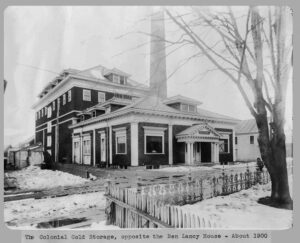PROVINCETOWN — Developer Christine Barker’s ambitious plan for 227 and 229 Commercial St., an expansion of her already-approved project at the adjoining Old Reliable Fish House site at 227R Commercial, took its first step forward in the local permitting process on April 5, winning the unanimous support of the town’s historic district commission.

At the hearing, Barker secured a certificate of appropriateness, required for changes to properties in the historic district. That certificate allows her to seek permits from other boards that will have to sign off on her plan to demolish the rear portions of the buildings at 227 and 229 Commercial and replace them with new structures, as well as to renovate two existing buildings on the properties.
Barker has not yet filed applications for any additional permissions, according to town records.
Barker purchased 227 and 229 Commercial from Scott Ravelson last summer from for $4.7 million. Now she seeks to add 18 to 20 hotel units, nine residential condos, and a restaurant with a bar and separate lounge area to the site. Parking is planned for beneath a new three-and-a-half-story building at 229. The development also encompasses the “Little Red” building at 227 Commercial St., which Barker wants to renovate to house a bookshop or other small retail operation that will open to a glass-enclosed conservatory where a small shed now stands.
Her previously approved project at the Old Reliable site on the waterfront calls for a mixed-use building with 31 hotel rooms and four condos, a restaurant, bar, and meeting space, some parking, and a 264-foot-long pier. The small alley between the former Ravelson building and Marine Specialties will be widened to a public walkway as part of the project, extending from Commercial Street down to the pier.
Barker’s architect, Jeffry Burchard, offered a slide presentation to the commission showing what the area looked like a century ago when the harbor bustled with fishing vessels, and the waterfront was lined with massive buildings used for ice-making, storing fish, and shipping operations.
“What we’ve noticed, and I think what a lot of people have noticed, is that the maritime culture has been lost in some respects because of a refocusing of energy on Commercial Street over the past century,” Burchard said. “Christine’s motivation here is to recreate and to restore and to celebrate the historic maritime culture of Provincetown.”
A century ago, the Colonial Cold Storage company owned 229 Commercial St. The front building was its engine room. Behind it stood the five-story icehouse, which was demolished around 1940 and replaced by a now-dilapidated warehouse and apartment building.
Barker proposes a new building that will be nearly as tall as the five-story cold storage building. Like the structure planned for the Old Reliable Fish House site, the first floor in the new three-and-a-half-story hotel complex will sit on a platform 19 feet above sea level to meet FEMA requirements, boosting the roofline to 69 feet above sea level.
According to Burchard, the height would still end up about four to five feet lower than the original cold storage building.
The engine room building will remain and will be refurbished. Neither that building nor the Little Red store will be boosted onto FEMA platforms, and both will be equipped with ADA access, according to the presentation.
The commission received several letters supporting Barker’s proposal, but the first person to comment during the hearing was opposed.
Businessman Patrick Patrick, who owns Marine Specialties, complained to the commission about the height and mass of the proposed building. “I believe the building exceeds what could be accessed by fire equipment,” he said. “I would suggest that we don’t replace the old fire-risk building with a new one that is a fire risk because it’s too tall for the town to fight a fire on.”
Patrick is the last of Barker’s opponents still making a legal case against the development; his suit blocking progress on the initial Old Reliable Fish House project is now in Land Court.
But an abutter on the other side of 227 and 229 Commercial said he was also not happy with Barker’s new plans. “We found out about this project in the Independent,” said Loic Rossignon, who owns the Canteen with Rob Anderson. “We were not consulted or asked opinions or questions.”
The massive building would dwarf the Canteen, he said, and its 32 windows would “look down on us and also look into the apartment Rob and I have been living in for 12 years.”
Several speakers offered support. Michelle Lohr, a resident and former travel writer, said Barker’s development would draw people to town during the tourist season, shoulder season, and “in the dead of winter.”
Patrick Wilson, owner of the Bradford House and Motel, said some of the project’s environmental components “should be a beacon for all future projects of this scale.” Barker’s mention of solar roof tiles had inspired him to replace those on his hotel, he said.
The historic district commission members were for the most part enthusiastic. Alternate member Thomas Biggert did have one complaint: “I don’t like the balconies and the way they stick out,” he said. “It looks like a hotel in Boston. Other than that, I think it’s brilliant.”
Commissioner John Dowd cited the need for more places for vacationers to stay. “And the fact you are completely bringing this building back to 1910 is something we all live in hope for,” he said. “I think this is a win-win for the historic district and for the town in terms of the ecosystem here.”
Commissioner Michela Murphy came down somewhere in the middle. “I do understand where the abutters are coming from,” she said. “I was also very daunted by the massing.”
But Murphy voted to approve Barker’s certificate.
“We’ve lost so much in Provincetown,” Murphy said, “and there are very few opportunities where you can bring something back that was there before.”
